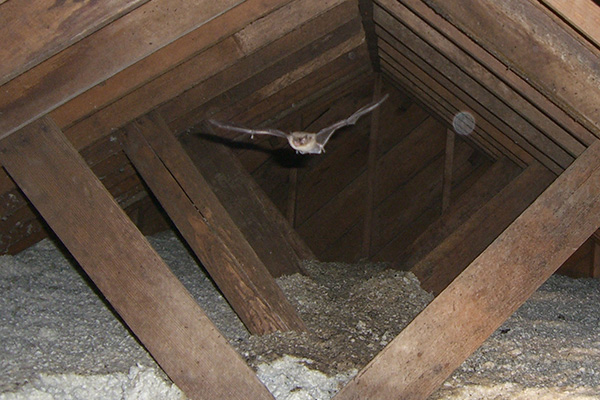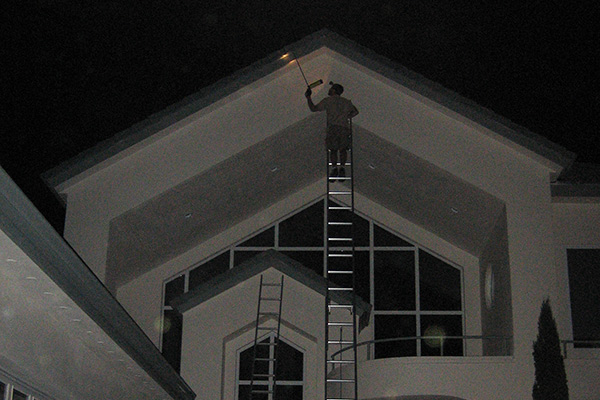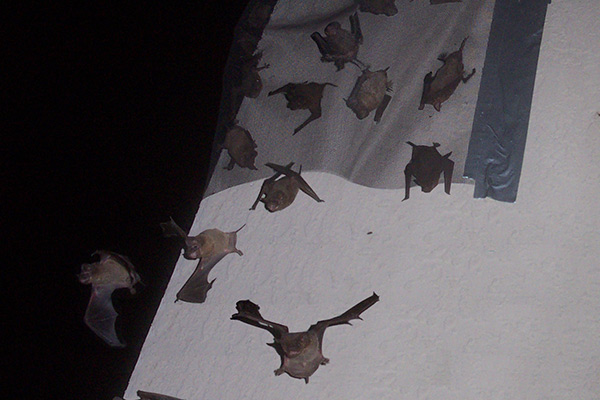- info@animalatticpest.com
- Call - we service 300 locations

How to Trap Bats - Bat Trapping Tips
Trapping bats may seem like the right approach, but it's not. Trapping them is illegal, and it's a lot more work than simply doing a live exclusion, of letting them naturally fly out on their own through one-way doors that you set. Besides, if
you trap bats in a cage or net, what exactly do you plan to do with them? You can't relocate them, because they'll fly 1000 miles back home in a few nights. You're not planning to illegally kill them, are you? If so, why? There's no need if you
seal the entry holes into your house properly.
Follow the below 4 steps. First, inspect your attic to find out the species. Be sure it's not the maternity season before starting any bat removal work. If it is, wait until mid-August or later. Next, watch the house at dusk, and preferrably
dawn as well, so you can identify EXACTLY where the bats are getting in and out. It can actually be tricky. What looks to you like the edge of the eave could actually be the fascia board, and so on. They sneak out of tiny cracks very quietly. Next, use
a ladder and inspect every inch of your house, especially the rooflines, eave gaps, soffits and soffit vents, gable vents, base of chimney, roof peaks, and so on. Seal shut all but the primary entry/exit holes. Watch the house at the next dusk to make
sure they are still able to get out. Then install exclusion funnels or netting on these openings. It must be set just right - to allow the bats to fly out, but not back in. Observe at dusk and night to make sure they are able to get out, and if not,
remove them immediately. You probably also want to inspect at dawn to make sure they can't get back in at the devices or anywhere else. Watch the exclusion areas for at least 3 nights, to make sure they are all out, and none are trapped inside. When you
are absolutely certain all the bats are out, remove the exclusion devices and seal shut those entry holes. Do it perfectly, or the bats will get back in! Next, clean the feces and urine in the attic.
Photographs of Various Bat Trapping Alternatives
1 - Home & Attic Inspection
Do two crucial things: inspect inside the attic to identify bat species and colony size, and watch the outside of the house at dusk, to see where they are flying out.
2 - Seal Bat Entry Holes
Once you have identified the primary entry/exit spots, LEAVE THEM OPEN, but seal off 100% of secondary areas. It's best done at night, with a light, for better vision.
3 - Perform the Bat Exclusion
Set the bat exclusion funnels or netting on the primary exit holes, which you left open Observe for 3 nights, to make sure the bats can get out but not back in!
Information and Tips About Bat Trapping
Should you ever trap a bat in a cage? There are those kind-hearted people out there that hate to see any kind of animal killed or destroyed, and so they opt for the most humane option to remove them from their property. They use traps or other mechanisms that allow them to capture the beast and then take it somewhere else to let it go.
This may seem like a nice thing to do, but there are certain animals you simply should not be willing to trap, and the bat is one of them. This is as much of a safety issue as it is anything else, and your health needs to be first and foremost.
Consider how bats act when they are captured. While most animals look to attack to just be released and get away, bats attack to harm and to injure. Because they carry diseases and parasites if they are to cut you or bite you they can cause serious injury to you or your family. This can be so very dangerous.
Also, if you do not get to the cage right away, but your pet or child does you may have made it so that they can be easily injured. A curious child or cat coming upon that cage is going to be attacked, and because bats are so small and wiry they are able to get at least a small portion of themselves, including a claw outside of the cage. This means they can claw at virtually anything near the cage.
These are frantic animals when captured and so they will lash out. This is not a possibility but is instead exactly what they will do.
While 99 percent of the time you should never try to trap a bat, there is one instance where you will absolutely need to do so. If you find that your child or pet was bitten by a bat that is in or around your home, then you most certainly need to capture this animal. The reason is quite simple. That bat could be carrying a disease, like rabies, and you need to have it tested to make sure that your pet or child is safe and free from these illnesses. Trapping the bat becomes imperative.
You may find that you are unable to capture that specific bat, but if you can catch one in the colony that it is living in this may be good enough. If one bat in that colony is carrying the disease, it is likely that others are as well.
The Bottom Line
Trapping bats in the attic. Remember, you do a live exclusion that lets them fly away free, instead of trapping them in a cage. You can remove bats from the attic if you follow the correct approach. Best of luck!




